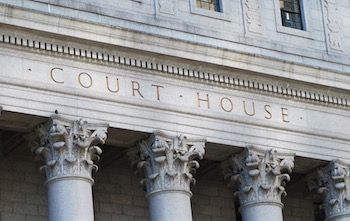A Decision for Tam Would Likely Result in Striking All “Immoral, Scandalous, or Disparaging” Restrictions, Not Just Disparaging.
Social media, eCommerce, customizable clothing companies, and a changing culture have made it much more commonplace to encounter offensive or scandalous content in public, and, to a much lesser extent, in the marketplace. Indeed, the world of brand names has remained mostly chaste, in large part because such a mark would not be easily enforced. It would be rejected from registration as being immoral, scandalous, or disparaging, and, thus, unregistrable on the U.S. Principal Register under Section 2(a) of the Lanham Act, which states that:
No trademark by which the goods of applicant may be distinguished from the goods of others shall be refused registration on the principal register on account of its nature unless it—(a) consists of or compromises immoral… or scandalous matter; or matter which may disparage… persons, living or dead, institutions, beliefs, or national symbols, or bring them into contempt, or disrepute. (15 U.S.C. § 1052(a))
For example, under Section 2(a), the United States Patent and Trademark Office has considered, and rejected, “BULLSHIT” for beverages (In re Red Bull GMbH, 78 U.S.P.Q. 1375 (TTAB 2006)), “A-HOLE PATROL” for an online comedy social club (In re Jobjab Media, Inc. App. No. 78951377 (TTAB Feb. 4, 2009)), and “THE CHRISTIAN PROSTITUTE” for clothing (USPTO Application No. 85951092). The Cards Against Humanity creators could easily cruise the USPTO Trademark Electronic Search System for some creative inspiration.
However, those rejections may soon become acceptances. In the landmark case of Lee v. Tam, Respondent Simon Shiao Tam, armed with the sword and shield of the First Amendment, hopes to convince the Supreme Court to pierce Section 2(a) and allow registry of his band name THE SLANTS on the Principal Register. THE SLANTS had been rejected from registration by the USPTO on the ground that the examining attorney found the band name likely disparaged people of Asian descent.
Although the Trademark Trial and Appeal Board affirmed the rejection, the Federal Circuit sitting en banc held Section 2(a)’s disparagement provision unconstitutional. The majority argued that Section 2(a)’s prohibition on disparaging marks is both content and viewpoint discriminatory, both singling out “disparaging” speech as a subject matter for regulation and discriminating among viewpoints to eliminate marks that disparage, but not praise, certain groups or ideas. As such, under First Amendment jurisprudence, Section 2(a) faced and failed strict scrutiny.
The case has since been appealed to the Supreme Court, who granted certiorari in autumn of last year. If the Supreme Court affirms the Federal Court, the decision could change the landscape of trademark registration dramatically.
SCOTUS Oral Argument Indicates Possible Split
 The Supreme Court heard oral argument on the cloudy Wednesday morning of January 18, 2017. Although the Justices posed tough questions and intricate hypotheticals to both sides, the tone of each Justice’s questions and their individual jurisprudences indicate an even 4-4 split, with Justices Breyer, Ginsberg, Kagan, and Sotomayor favoring the USPTO, and Justices Alito, Kennedy, Thomas, and Chief Justice Roberts favoring Tam. Of course, oral argument is often shaky, at best, when predicting the outcome of a case, especially one with such potential for a drastic overhaul of a body of law.
The Supreme Court heard oral argument on the cloudy Wednesday morning of January 18, 2017. Although the Justices posed tough questions and intricate hypotheticals to both sides, the tone of each Justice’s questions and their individual jurisprudences indicate an even 4-4 split, with Justices Breyer, Ginsberg, Kagan, and Sotomayor favoring the USPTO, and Justices Alito, Kennedy, Thomas, and Chief Justice Roberts favoring Tam. Of course, oral argument is often shaky, at best, when predicting the outcome of a case, especially one with such potential for a drastic overhaul of a body of law.
Although no one can know for certain the outcome of Lee v. Tam, one consequence that appears very likely is that, if the Court does rule in favor Tam, it would strike the entirety of Section 2(a), not just the portion prohibiting disparaging marks that forms the central issue of the case. John C. Connell, counsel for Tam, went so far as to call that result “inevitable” in response to Justice Ginsberg’s question on the topic.
If all three restrictions are struck, the Court would be acknowledging an expressive element to trademark worthy of robust First Amendment protection, which, until now in intellectual property law, has been afforded exclusively to copyright. However, this concept of baking an expressive speech element into a trademark seems to run awry of a trademark’s undeniably commercial purpose: to give exclusivity to the indication of the source of a good or service. This is covered in the opinion for Qualitex v. Jacobson Prods., which stated that:
In principle, trademark law, by preventing others from copying a source-identifying mark, reduces the customer’s costs of shopping and making purchasing decisions, for it quickly and easily assures a potential customer that this item—the item with this mark—is made by the same producer as other similarly marked items that he or she liked (or disliked) in the past.
At the same time, the law helps assure a producer that it (and not an imitating competitor) will reap the financial, reputation-related rewards associated with a desirable product. The law thereby encourages the production of quality products and simultaneously discourages those who hope to sell inferior products by capitalizing on a consumer’s inability quickly to evaluate the quality of an item offered for sale. (514 U.S. 159 (1995))
Acknowledgement that an element of expressive speech is “inextricably intertwined” with a trademark’s commercial speech purpose could produce bizarre and unprecedented results.
The Federal Circuit had no trouble arriving at the conclusion that trademarks have an expressive element, stating “[t]his case exemplifies how marks often have an expressive aspect over and above their commercial-speech aspect.” (Tam, 808 F.3d at 1338).
The majority opinion highlighted that, beyond establishing exclusive indication of source, THE SLANTS also projects an expressive statement about racial and ethnic identity with the purpose of creating a dialogue on controversial political and social issues. However, sweeping acknowledgement that trademarks have an expressive element forces the question of how the government will be allowed to police those marks in practice. For example, currently, the right to exclude others’ use of a mark extends to commercial use, but not expressive use, such as parody. (See, for example, Jordache Enter., Inc. v. Hogg Wyld, Ltd., 828 F.2d 1482 (10th Cir. 1987) and Louis Vuitton Malletier S.A. v. Haute Diggity Dog, LLC, 507 F.3d 252 (4th Cir. 2007).
The injection of broad First Amendment protection into the expressive aspects of all marks allows for registration of marks that would otherwise be rejected as “immoral” or “scandalous” as well. This would mean that, not only would the “disparaging” category of marks be registrable (such as, THE SLANTS and THE CHRISTIAN PROSTITUTE), but the “immoral” and “scandalous” marks would be registrable, too (e.g., “BULLSHIT” and “THE A-HOLE PATROL”). The examples below illustrate some of the implications of this choice.
Currently, applications that use the word “marijuana” are also usually rejected under Section 2(a)’s prohibition on marks containing immoral or scandalous matter, because marijuana remains illegal under federal law. For example, MARIJUANA COLA for medicinal drinks was rejected, “because marijuana is an illegal drug or substance (Office Action of Nov. 17, 2009 for Ser. No. 77671304); and MARIJUANA for other beverages was rejected, because: “The term MARIJUANA refers to an illicit drug that is associated with illegal behavior and adverse health consequences. The proposed mark is therefore immoral or scandalous and thus unregistrable.” (Office Action of October 12, 2006, Ser. No. 78401566)
In the wake of Lee v. Tam’s potential outcome of striking Section 2(a) in its entirety, if the applicant for MARIJUANA COLA were to reapply, claiming that its mark is expressive with the purpose to engage the public in a meaningful political discourse about the benefits of cannabis, the federal government would be without recourse. The USPTO would have to register the mark despite marijuana’s continued illegality under federal law.
Similarly, overtly sexual marks are also generally rejected as being immoral or scandalous. For example, the TTAB rejected the application for the mark SEX ROD in a precedential decision under Section 2(a). It even rejected the applicant’s parody defense—the parody being on the phrase “Red Sox”—on the ground that “the parody, to the extent there is one, is itself vulgar.” (Boston Red Sox Baseball Club Ltd. v. Brad Francis Sherman, Opposition No. 91172268 (TTAB 2008))
Again, upon reconsideration after Lee v. Tam, the TTAB likely would have no choice but to register SEX ROD if the Court enshrines First Amendment protections within the expressive aspects of such marks and rules Section 2(a) unconstitutional. However, the Court would then be giving a parody—albeit, a sexual parody—trademark protection, as well its exclusive commercial use as an indication of source. No other user could poke fun at the Red Sox using the term SEX ROD. Is that a protection of free speech, or a limitation on it? Would another user be excluded from the right to create a sexual parody of the Red Sox? We explore one way to reconcile this dilemma below.
Reconciling the Ridiculous
At the end of the day, once an applicant applies for trademark registration, she is asserting that her mark has a commercial purpose, not simply an expressive one. The fundamental commercial purpose of trademarks will not vanish after Lee v. Tam, regardless of how the Court decides the case. However, this case has opened the proverbial can of worms regarding the strain between commercial and expressive aspects of trademarks.
For example, if granted full registration for THE SLANTS, Mr. Tam would gain the right to exclude all others from commercializing that phrase in relation to musical groups. Mr. Tam could very likely not only stop another’s use for a band, but also for other forms of entertainment, such as television shows or museum exhibitions. These results seem counter to the fundamental goals of the First Amendment.
These possibilities weigh heavily upon many ongoing controversial trademark battles, such as Pro-Football, Inc. v. Blackhorse et al.,[1] which centers upon whether Pro-Football’s REDSKINS mark is disparaging to Native American groups (No. 1:14-cv-01043-GBL-IDD (E.D. Va. 2015)).
If the Supreme Court strikes Section 2(a) in its entirety, then the Native American groups opposed to the term “REDSKINS” will have no legal grounds to oppose Pro-Football, Inc.’s use of the word. Moreover, under Tam, Pro-Football may then be able to block those Native American groups from ever reclaiming that word through use in an expressive context. Again, such results seem counter to the First Amendment and to the commercial purpose of trademark law.
One manner of reconciling the commercial and expressive aspects of trademark may be to acknowledge that, although trademarks do have expressive elements, those expressive elements are inherently weak, because others have a right to express them, as well. The law already draws a distinction in the scope of protection between strong distinctive marks and weak descriptive marks. Perhaps “expressive” marks belong in the same category as weak descriptive marks. The PTO could give expressive marks a much more limited scope in light of this weakness.
Registration of expressive marks could even be confined to the Supplemental Register with its limited, although still actionable, protections. In that event, the Supplemental Register would become the parking lot for marks that are otherwise not registrable due to weakness, but the law allows them registry, because they have acquired a secondary and/or expressive meaning.
By recognizing the weakness of expressive marks in one of these ways the public would not lawfully be able to use THE SLANTS or REDSKINS to start a band or a football team, but could still use those terms to advance discourse and free speech. In any case, if we see THE SLANTS sporting an “®” after the Tam decision, we certainly will also be seeing the “®” on a lot of marks for new and intriguing products and services in future.

![[IPWatchdog Logo]](https://ipwatchdog.com/wp-content/themes/IPWatchdog%20-%202023/assets/images/temp/logo-small@2x.png)



![[Advertisement]](https://ipwatchdog.com/wp-content/uploads/2024/04/Patent-Litigation-Masters-2024-sidebar-early-bird-ends-Apr-21-last-chance-700x500-1.jpg)

![[Advertisement]](https://ipwatchdog.com/wp-content/uploads/2021/12/WEBINAR-336-x-280-px.png)
![[Advertisement]](https://ipwatchdog.com/wp-content/uploads/2021/12/2021-Patent-Practice-on-Demand-recorded-Feb-2021-336-x-280.jpg)
![[Advertisement]](https://ipwatchdog.com/wp-content/uploads/2021/12/Ad-4-The-Invent-Patent-System™.png)







Join the Discussion
One comment so far.
Anon
April 3, 2017 07:28 amAnother Anon on another blog recently stated the following (which applies not only to academics, but apparently, also to attorneys):
“Note: This is not particularly about the current Guest Post, but something a bit more meta, I’d like to engage others in.
The differences between social activism (SA) and academic scholarship (AS) are legion.
I find it particularly interesting that:
whereas one of these anticipates and is often coincidental with pending or on-going actions before the court or government institutions;
the other will often post-date a noteworthy or important development, putting it in perspective after the fact as thoroughly as academic scholarship enables,
and regardless of how successful they are at their respective endeavors,
one (SA) aims to present a particular persuasive position in the hopes of swaying that court or institution, whereas
the other (AS) aims to provide objective and accurate scholarship analyzing from a dispassionate distance, the result or action of the court or institution,
whereas one (SA) IS for affecting or effecting a result,
the other (AS) IS for scholarly understanding of a result.
This is not news (fake or real) to anyone. I still find this interesting to think about and keep in mind from time to time. Various blogs and sites have papers/posts/articles which vary from AS to SA. Given the ongoing political war between collectivism and individualism, SA is unavoidable in an area touching on property rights (IP and patent law), so every site and blog will have some of that if not explicitly, implicitly.
I’m wondering if anyone would care to rank sites or blogs regarding the level of AS or ratio of Academic Scholarship (AS) to Social Activism (SA)?”
I find several issues with the piece her written by the trio of attorneys.
1) the decision below stated that not only would this fail strict scrutiny, it would fail intermediate scrutiny as well.
2) there are plenty of items that have been passed as Trademarks that are as equally “disparaging” and the like as the cherry-picked list provided here.
3) even business speech carries with it Freedom of Speech when that business speech is expressive.
I find this article far too “reaching” in order to advocate for a particular End result, and far too light on a balanced and objective view of the actual legal principles that should guide the resolution of the case.
This article by the trio of attorneys is activism dressed as scholarship.
Nothing more.